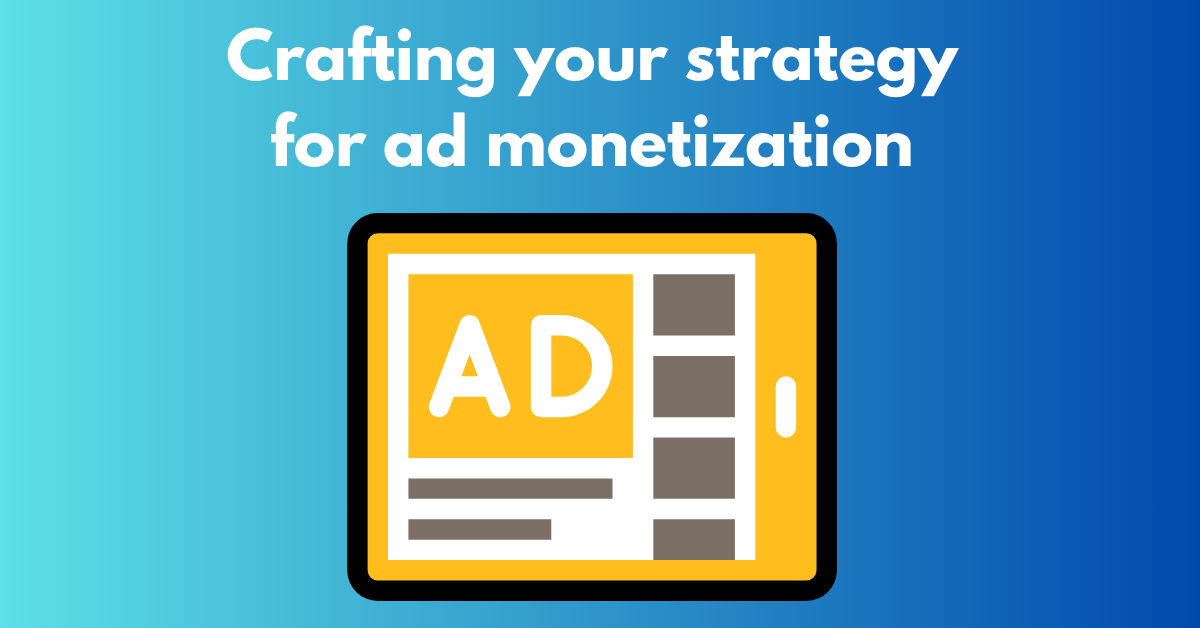In the upcoming blogs, you’ll explore the essential elements of mobile game monetization. You don’t need a highly aggressive strategy to generate revenue – just a smart, well-thought-out approach.
Developers are increasingly adopting ad monetization, and the supporting technology has grown more sophisticated. When implemented strategically, ads can boost your revenue while positively influencing key metrics for your game.
Now, let’s dive in!

Considering ad monetization early in the game design process
Before we explore the different types of ads for ad monetization, it’s essential to discuss when to start planning your ad monetization strategy. While some developers might be inclined to build and launch their game first, then add ads later, it’s crucial to think about your ad strategy right from the start of game development.
The most effective ads should feel like a natural part of your in-app economy and overall experience. For example, with opt-in ads like rewarded videos and offerwalls, users receive tangible in-game currency in exchange for watching an ad. Ensuring these ads align with your broader game economy is essential.
Ads that perform best are those integrated directly into the core game loop, complementing the in-game economy. In other words, ads should function as a key element of your game.
By planning for ads early in development, you can seamlessly incorporate them into the core game loop, enhancing the user experience and maximizing ad revenue.
User-Initiated Ads: Unlock Revenue with Offerwalls and Rewarded Videos
To start serving ads in your game, integrate the SDK of a mediation platform, which gives you access to multiple ad networks like Unity Ads, Google AdMob, or ironSource. This concept was covered in the previous course.
Ads are split into two categories: user-initiated and system-initiated, catering to various engagement levels among your players.
Always begin with user-initiated ads, so let’s start there.
User-initiated ads are those that users actively opt into, meaning they make a conscious decision to engage with the ad. These ads are never shown disruptively or against the user’s will, which offers significant benefits to you, your players, and advertisers.
The primary user-initiated ad units are rewarded videos and offerwalls.
These ads encourage users to play longer and boost retention by allowing them to progress in your game without spending money—just their time. Since users willingly choose to interact with these ads, they typically result in a very positive experience.
Advertisers tend to pay more for user-initiated ads because they perform well. The opt-in nature of these ads ensures users are more receptive to the ad experience and open to the messaging.
A rewarded video typically lasts about 20 seconds and shows a video or playable ad. As the name implies, players are rewarded with in-game currency, extra lives, or cool upgrades after watching the full ad.
Rewarded videos work well for players who are engaged enough to watch a short ad but aren’t ready to commit to a more time-consuming offerwall task or an in-app purchase.
For more engaged users—those willing to invest more time completing an event but not yet ready to make an in-app purchase—offerwalls are a great option. Offerwalls present users with tasks like “download and finish the tutorial” or “reach level 3” in another game. Once the task is completed, users will receive rewards for your game.
Some developers may wonder if directing users to another game could lead to losing them. However, only users highly motivated to earn rewards in your game would spend time completing tasks in other games. Data shows that offerwalls can boost retention rates, as players use these rewards to overcome sticking points in their game.
Offerwalls, like rewarded videos, can also increase in-app purchase revenue by giving users a “taste” of premium content they would normally have to pay for. This experience entices them to invest more in your game later on.
Boost Your Game with System-Initiated Ads
In every game, regardless of the genre, some players don’t engage with user-initiated ads or make in-app purchases. To monetize these players, developers can use system-initiated ads, which players don’t opt into—developers decide when to display them.
The main types of ad units include interstitials, which take over the screen with a full-page static image, video, or playable ad, and banners, which appear as rectangular ads that stay sticky at the top or bottom of the screen throughout the session. Sometimes, the ads within the banner refresh themselves, and you can also use moving banners, like GIFs, in addition to static images.
It’s best to display system-initiated ads to users who don’t make in-app purchases or engage with user-initiated ads. This approach focuses on user segmentation, which we’ll discuss in another episode, and needs to balance with retention, which we’ll cover shortly!
Thinking about ads’ relationship with IAPs and retention
When you design your ad unit strategy, focus not only on revenue but also on two key factors: how ads affect your game’s in-app purchases (IAPs) and how they influence retention.
In the relationship between IAPs and user-initiated ads, the most critical aspect to consider is cannibalization. Avoid overwhelming users with too much premium content from your offerwalls and rewarded videos. If users receive excessive rewards, those who would typically spend money in your game’s store may lose their incentive to do so, limiting your game’s average revenue per user (ARPU).
For rewarded videos, we recommend offering players soft currency and additional rewards that aren’t available for purchase in your store. In contrast, for offerwalls, we suggest using hard currency—such as high-value items like diamonds—that players find challenging to earn through gameplay.
Later in this course, we’ll explain how to set the perfect rewards and share other best practices for ads.
System-initiated ads generally pose a greater concern for retention because users don’t opt-in, which can make these ads feel disruptive or intrusive. Conduct A/B tests to determine the optimal number of interstitial and banner ads to show users in a single session and their ideal placement. Finding this sweet spot is essential to avoid annoying users and negatively impacting retention, but once you do, it’ll pay off.
Ad monetization management
To effectively manage your monetization strategy, you need to integrate all aspects—such as the types of ads you’ll use, their placement, and target audience—into a cohesive operation. You want your monetization strategy to function like a well-oiled machine.
This is where mediation platforms come into play. These platforms connect you to multiple ad networks through a single access point or SDK. You’ll use a mediation platform to run your waterfalls or in-app bidding operations.
Waterfall monetization is one ad-serving model. In brief, waterfalls allow you to offer your game’s ad space to various ad networks, creating competition. Based on the different descending price points you set, your ad request cascades down the waterfall until a network decides to meet your price, filling the offer. While this method has been the industry standard for the last decade, it’s beginning to shift.
In-app bidding is quickly becoming the dominant method for mobile game developers to monetize their users. The great news is that it requires minimal active management from developers to optimize efficiency and revenue. In this model, networks participate in an auction simultaneously, each bidding on how much they’re willing to pay to serve the ad. The network with the highest bid wins the auction and serves the ad.
Many developers adopt a hybrid monetization setup that combines bidding with traditional waterfalls.
This approach allows you to access inventory from preferred ad networks that lack bidding technology while leveraging the benefits of bidding from others.
In a hybrid flow, the auction results merge with the waterfall results, placing the winning bid into the waterfall according to its price point.
In-app bidding maximizes revenue, reduces latency, and simplifies management.
Why is it easier to operate?
Unlike waterfalls, in-app bidding automates the process, eliminating the need to position bidding networks or manually input CPM.
Latency, which may cause users to face a blank screen while the system fills the ad space, is another concern.
Bidding reduces latency by asking all networks at once instead of cascading through them like in waterfalls. This approach ensures a better user experience.
Lastly, bidding increases your revenue by fostering competition among networks for your ad space. With everyone striving to win the auction, networks will bid higher to outbid each other.
In today’s monetization landscape, in-app bidding is swiftly becoming the default ad-serving technology, especially for small game and app developers with limited manpower or resources for monetization optimization.
And this blog isn’t enough to learn more about the level-up Academy from ironSource on Offerwall


